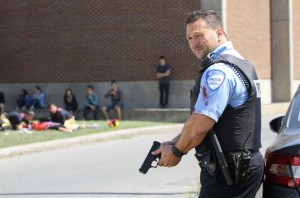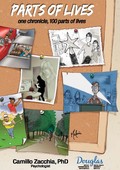
Following the shootings at Newtown, I was called by a journalist who wanted to know what I thought of the fact certain schools were planning to practice lockdown drills. I wasn’t free to film a segment for his report but I decided to address the topic in my column of February 12, 2013.
There are two main issues in my mind. The first concerns the issue of relative risk. When we focus on something that grabs our attention, we may end up focussing on a tiny risk while ignoring much bigger ones as a result. Making a decision while emotional rarely makes sense. A guy should probably not tattoo the name of the woman he just met on his arm, a woman should probably not join a convent right after a break-up, and you should probably not tear up your driver’s licence after an accident. While some events are more serious than others, important decisions are best made while in a rational state of mind allowing for all factors to be considered fairly.
The other concern I have is with the mindset we create when we focus on the most extreme elements of society. We create the impression that the world is a dangerous place. The fact is it is neither safe nor dangerous. It is both in parts. However it is far more safe than we tend to think. This is because dramatic events affect fear and fear affects perceptions. Reality doesn’t change very quickly but a perception can, and I don’t think we should be giving the wrong impression that we are surrounded by crazed killers.
My feeling is that I should be vigilant to the dangers around me but I don’t want to live in a world where I see murderous potential in every encounter. I am surrounded by too many millions of good people. I don’t want to lose touch with them by placing too much emphasis on the evil few.
Danger is always real but relative. Focussing on what is PROBABLE keeps us RELATIVELY safe. Focussing instead on what is POSSIBLE will condemn us all to live in virtual prisons.
Prepping for the latest nightmare
(Source: Le dernier danger en lice. Journal Métro, February 12, 2013)
Voir plus bas pour la version Française.It has now come to this. More and more schools are practicing lock-down drills as a way of preparing school children in the event of a mass shooting.
Yeah, sure, let’s mobilize mass resources to protect society by teaching us how to run from bullets rather than by eliminating the weapons that fire them. But I digress…
Anxiety the good
When I was in school, teachers drilled ‘stop, look and listen’ into our heads. They were tired of hearing about children hit and killed by cars. Their goal was simple; make us more scared so we will be careful when crossing the street.Anxiety is a basic survival instinct designed to protect us. We will run from tigers and snakes because these animals present real dangers in the wild. But running out from between parked cars, riding a bike without a helmet, or playing with matches doesn’t normally scare kids. Our instincts evolved in a world with tigers and snakes not cars and bicycles. This is why we need to drill certain fears into our children.
Anxiety the bad
The problem with fear is that it restricts us. If there are predators in the forest where I would otherwise hunt, I might have to make do with the berries and roots near my cave. It’s a price worth paying in exchange for the added protection. But what if my modern day fears are exaggerated? I may avoid jobs that require travel for fear of airplanes, or drop out of school for fear of doing an oral presentation. In such cases, the price to pay is too high. If I listen to every irrational fear I won’t have much of a life.Anxiety the reasonable
So what then do we teach our children? Should we prepare them in cases of mass shootings? Well, when dangers are significant it is wise to create added anxiety. This will result in important protection. For example, I think kids should be scared to ride a bike or snowboard without a helmet. It is a small price to pay for real protection. But shootings? Do we want our children to live in a prison?All dangers are relative but the perception of them can be distorted following a highly dramatic event, regardless of how rare it is. The question we must ask is will this added fear result in any real added protection or simply in more restrictions on freedom and our sense of security? Worse yet, will focus on the latest sensational scare distract us from more significant dangers that get lost in the shuffle such as fires, head injuries, and car accidents while texting?
________________________________________________________________
Voici la version Française:
Nous en sommes là. De plus en plus d’écoles effectuent des exercices de préparation à d’éventuelles tueries.
Nous mobilisons des ressources pour montrer à notre société comment se protéger et fuir les balles, plutôt que d’éliminer les armes qui les tirent. Mais, je m’éloigne…
La bonne anxiété
Quand j’allais à l’école, les professeurs voulaient que nous soyons vigilants en traversant la rue. Plutôt que d’apprendre que des enfants s’étaient fait happer mortellement par des voitures, ils nous enseignaient à nous répéter mentalement : « Arrête, écoute et regarde. ».L’anxiété fait partie de l’instinct de survie destiné à nous protéger. Nous fuirons les tigres et les serpents en liberté parce qu’ils présentent de réels dangers. Mais courir entre deux voitures garées, faire du vélo sans casque et jouer avec des allumettes n’effraient habituellement pas les enfants. Notre instinct s’est développé au milieu de tigres et de serpents, et non de voitures et de vélos. C’est pourquoi nous devons inculquer certaines peurs à nos enfants.
La mauvaise anxiété
Le problème, avec la peur, est qu’elle nous limite. S’il y a des prédateurs dans la forêt où je voudrais chasser, je devrai peut-être me contenter des fruits et des racines qui se trouvent à proximité de ma caverne. C’est le prix à payer pour jouir d’une plus grande protection. Et si mes peurs contemporaines étaient exagérées? Je peux éviter les emplois qui nécessitent des déplacements, par peur des avions, ou abandonner mes études, par peur de faire un exposé. Le prix à payer est alors trop élevé. Si je me laisse aller à toutes mes peurs irrationnelles, je n’aurai plus de vie.L’anxiété raisonnable
Alors, que doit-on enseigner à nos enfants? Devrions-nous les préparer à des tueries? Eh bien, lorsque les dangers sont importants, il est avisé d’augmenter leur degré d’anxiété, ce qui permettra d’accroître leur protection. Ainsi, je crois que les enfants devraient craindre de monter à vélo ou de faire de la planche à neige sans casque. C’est un faible prix à payer pour obtenir une véritable protection. Mais les tueries? Voulons-nous que nos enfants vivent dans des châteaux forts?Tous les dangers sont relatifs, mais la perception que nous en avons peut être déformée à la suite d’événements dramatiques, même s’ils sont rares. La question à se poser est celle-ci : cette nouvelle crainte donnera-t-elle lieu à un accroissement de la protection, ou restreindra-t-elle simplement davantage notre liberté et notre sentiment de sécurité? Pire encore, l’attention que nous accordons à la dernière crainte en lice nous détournera-t-elle des dangers importants que nous oublions dans ce brouhaha, comme les incendies, les traumatismes crâniens et les accidents de voiture que nous provoquons en envoyant des messages textes?
Tagged as Anxiety, gun-control, mass shootings, Newtown.
Posted in Anxiety.
Posted on 25 Feb 2013

On Mar 19th 2013 at 13:33
Je me souviens des risques que j’ai pris dans ma vie même si j’avais parfois quelque appréhension – comme de faire 150 heures en autobus seule de la Californie à Mexico City, à 21 ans. J’ai ainsi pu rencontrer des gens formidables que je n’aurais pas connus en restant dans mon salon. Et puis, j’ai fait de l’autostop de Montréal à Québec pour aller au Carnaval, ce qui est impensable de faire aujourd’hui. J’ai bien profité de la vie et malgré les dangers potentiels d’aujourd’hui, je compte continuer à vivre en prenant des risques CALCULÉS.